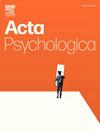Translation and psychometric evaluation of the Clance impostor phenomenon scale in Arabic-speaking individuals: Study of validity and reliability
IF 2.1
4区 心理学
Q2 PSYCHOLOGY, EXPERIMENTAL
引用次数: 0
Abstract
Background
Imposter Syndrome (IS), or Imposter Phenomenon (IP), is marked by persistent self-doubt and fear of being exposed as a fraud despite success. It's prevalent in high-achieving fields like medicine and is linked to anxiety and perfectionism. The Clance Imposter Phenomenon Scale (CIPS) is the most common assessment tool. This study aims to translate and validate an Arabic version of CIPS for Arabic-speaking populations.
Methods
This cross-sectional study was conducted at King Saud University, Riyadh, from August to September 2024, using a convenient sampling method. The survey gathered demographic details and included the Arabic version of the CIPS, the General Self-Esteem Scale (GSES), and The Big Three Perfectionism Scale (BTPS). Data were analyzed using IBM SPSS 22 (p < 0.05). Construct validity was assessed through Exploratory and Confirmatory Factor Analysis. Internal consistency (Cronbach's alpha ≥0.7), test-retest reliability (ICC >0.75), and discriminant validity were evaluated. Concurrent validity was examined using structural equation modelling and Pearson's correlation with GSES and BTPS.
Results
A total of 477 participants (66.5 % female, mean age 21.1 ± 2.0 years) completed the questionnaire. The Arabic CIPS demonstrated a three-factor structure in exploratory factor analysis (KMO = 0.936, Bartlett's test p < 0.001), with confirmatory factor analysis supporting good model fit (CFI = 0.87, RMSEA = 0.07). Internal consistency was excellent (Cronbach's α = 0.90), and test-retest reliability was acceptable (ICC = 0.71). Discriminant validity was supported by significant score differences across quartiles. CIPS correlated negatively with general self-efficacy (r = −0.39, p = 0.001) and positively with self-critical perfectionism (r = 0.68, p = 0.001) and rigid perfectionism (r = 0.46, p = 0.001), confirming its construct validity.
Conclusion
The Arabic CIPS is valid and reliable for use among medical and non-medical populations.
Clance冒名顶替者现象量表在阿拉伯语个体中的翻译与心理测量评估:效度与信度研究
海报综合症(IS),或冒名顶替现象(IP),其特征是持续的自我怀疑和害怕被暴露为骗子,尽管成功了。它在医学等高成就领域很普遍,与焦虑和完美主义有关。Clance冒名顶替现象量表(CIPS)是最常用的评估工具。本研究旨在为讲阿拉伯语的人群翻译和验证阿拉伯语版本的CIPS。方法本研究于2024年8 - 9月在利雅得沙特国王大学进行,采用方便抽样法。这项调查收集了人口统计细节,包括阿拉伯语版的CIPS、一般自尊量表(GSES)和三大完美主义量表(BTPS)。数据分析采用IBM SPSS 22 (p <;0.05)。通过探索性因子分析和验证性因子分析评估结构效度。评估内部一致性(Cronbach’s alpha≥0.7)、重测信度(ICC >0.75)和判别效度。采用结构方程模型和Pearson与GSES和BTPS的相关检验并发效度。结果共477人完成问卷调查,其中女性占66.5%,平均年龄21.1±2.0岁。探索性因子分析显示阿拉伯语CIPS呈三因子结构(KMO = 0.936, Bartlett检验p <;验证性因子分析支持良好的模型拟合(CFI = 0.87, RMSEA = 0.07)。内部一致性极好(Cronbach’s α = 0.90),重测信度可接受(ICC = 0.71)。四分位数之间的显著得分差异支持了判别效度。CIPS与一般自我效能负相关(r = - 0.39, p = 0.001),与自我批判完美主义(r = 0.68, p = 0.001)和严格完美主义(r = 0.46, p = 0.001)正相关,证实了其结构效度。结论阿拉伯语CIPS在医疗人群和非医疗人群中使用是有效可靠的。
本文章由计算机程序翻译,如有差异,请以英文原文为准。
求助全文
约1分钟内获得全文
求助全文
来源期刊

Acta Psychologica
PSYCHOLOGY, EXPERIMENTAL-
CiteScore
3.00
自引率
5.60%
发文量
274
审稿时长
36 weeks
期刊介绍:
Acta Psychologica publishes original articles and extended reviews on selected books in any area of experimental psychology. The focus of the Journal is on empirical studies and evaluative review articles that increase the theoretical understanding of human capabilities.
 求助内容:
求助内容: 应助结果提醒方式:
应助结果提醒方式:


